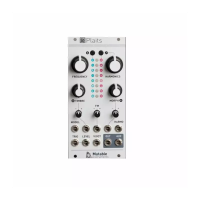The first half of the screen displays the version of the OS running on the motherboard. If a firmware
is present on the memory-card, pressing
will load it to upgrade the main processor.
are attached. The first 6 ports (port 1 to port 6) are
used for connecting the voicecards ; the last port (port 7) is used for connecting additional controllers
or I/O connectors. The second half of the screen on the
page shows the device type and OS
version number for a selected port. Use the encoder to scroll through the ports. When no device is
attached to a port (or when the device firmware has been corrupted), a ‘?’ is shown in place of the
device type. If a firmware update file named
(where $ is the port number) is present on
the memory card, pressing
(upgrade command) will load it to upgrade the voicecard processor.
If for some reason Ambika is “bricked” — this can happen if the SD card is damaged, if the firmware
update file has been incorrectly copied to the card, or if the power has been disconnected during the
firmware upgrade procedure — there is still a way of initiating a firmware update:
while powering up Ambika to force the firmware to be reloaded from the SD-card. During
loading, the unit displays the number of bytes loaded (the firmware takes up to 60kbytes):
while powering up Ambika to put the unit in
firmware upgrade mode. In this mode, the
unit is waiting for the firmware to be sent as SysEx blocks over
. A .syx or .mid file with the latest
data is available on the Mutable Instruments website. While receiving blocks of
displays the number of bytes loaded (the firmware takes up to 60kbytes):
If you want to use a dedicated SysEx transfer tool, we recommend Elektron’s C6 tool available for
both Windows and OS X, configured with a 250ms delay between blocks.
Ambika – User manual | Mutable Instruments http://mutable-instruments.net/ambika/manual
37 of 44 2/17/17 4:58 PM

